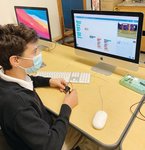

PROVIDENCE — Following a year in which a global pandemic posed significant challenges to schools everywhere, the Diocese of Providence’s Catholic Schools Office is reporting an increase of 4.85 percent in enrollments this year, primarily in its diocesan, parish and private elementary and middle schools. This represents a growth of 445 students over the 2020-2021 academic year.
Diocesan Vicar General and Moderator of the Curia Msgr. Albert A. Kenney expressed his gratitude to those who have worked very hard through the challenging times in order to make a high-quality Catholic school education accessible to even more local students and families.
“The Diocese of Providence has a long tradition of excellence in Catholic education,” Msgr. Kenney said.
“This increase in enrollment is more than just a matter of numbers. It means more young people will have the chance to learn about Christ and His Church. I am grateful to our hard-working pastors, outstanding principals and dedicated faculty at our Catholic schools. This is most welcome news.”
Arthur W. Lisi, Ph.D., principal of diocesan Msgr. Clarke School in Wakefield, touts a strong in-school response to COVID-19 as well as a cohesive administrative team and its dedication to personalized learning for its students as reasons for its increase of 67 students this year, a figure which includes the school’s Little Angels daycare program.
The spike in enrollment is especially welcome as the school began to struggle with diminishing annual enrollments in 2015 in response to a decline in the area’s population of school-aged children, along with rapid changes in its leadership.
“Positive change was put into motion and now, five years later, the school is seeing strong results,” Lisi told Rhode Island Catholic.
“The school realized a 35 percent increase in enrollment over the last five years. The growth has been steady and strong across all grades each year.”
Lisi attributes Msgr. Clarke’s success to its critical areas of strength, not the least of which is having strong leadership in place that values and understands critical educational elements that focus on strong, engaging academics, high expectations for all in a personal and nurturing environment.
Coupled with a strong leadership team is a sense of innovativeness that is tempered with a strong sense of mission that encompasses traditional and Christian values.
“The pandemic presented some challenges but we stayed true to our promise to Pray, Protect, Partner and Personalize,” Lisi said.
“Catholic schools need to make a shift in their thinking and understand the importance of development,” Lisi said. “The meaningful involvement of people in our schools mission and vision is at the core of everything we do.”
At All Saints STEAM Academy in Middletown, a diocesan school where enrollment has increased by 37 students this year, Principal Anita Brouse attributes the uptick to “the consistent efforts of our dedicated staff and faculty, whose creativity and commitment to their students has created a culture of inclusion and compassion.”
“Our welcoming attitude allows us to be open and flexible to new ideas and change in helping our students achieve their goals,” she said.
“Students understand that each person’s contributions are of value, and that we are all part of a team.”
Brouse said the pandemic transition mandate from in-person learning to remote online instruction was a seamless one as both students and teachers were fluent in using the technology that made remote learning possible.
The Arts portion of STEAM education allowed for shared screen birthday parties, pet shows, science fair projects, an Earth Day nature art gallery, and a YouTube presentation of the spring drama “Aladdin, Jr.,” which was presented through the collaboration of the drama director, technology director and the 17 students in the cast performing on their individual home-based green screens.
“It is the consistent quality instruction provided at All Saints, both before the pandemic challenge and especially during this time, that has drawn families to our community,” Brouse said.
At St. Cecilia School in Pawtucket, which saw 23 new students enroll this year, Principal Mary E. Tetzner, M.Ed., said that enrollment had also increased in the summer before the 2020-2021 school year, with the school opening full in-person instruction from grades Pre-K-5 and operating under a hybrid instruction model for grades 6-8.
“Halfway through the 2020-2021 school year we opened the school for full in-person learning,” she said. “Many parents told me they needed to return to work and they were not able to stay home with their children any longer.”
Parents later reported that they were very happy with the education their children were receiving.
“They also liked the caring, nurturing environment of the school,” Tetzner said.
“I feel a testament to how well we did during the pandemic is that all of the new students who entered from the 2020-2021 school year are enrolled for the 2021-2022 school year.”
Using grant money, Tetzner made capital improvements to bolster technology at the school, including the complete rewiring of its internet system to allow for faster speeds and connection stability, and the addition of 30 new terminals for the computer classroom, along with 48 new Google Chromebooks.
“Updating the technology was crucial to making this work for our school,” Tetzner said.
St. Rose of Lima School in Warwick saw its enrollment increase by 36 students this year, according to the figures compiled by the Catholic Schools Office and reported to the National Catholic Education Association.
During the pandemic the school developed a plan to provide a safe environment for its students to the greatest extent possible, using all available resources.
“We composed a reopening plan that developed creative strategies to have the children back in-school in a healthy and safe environment. With our continued increased enrollment this year we added positions so that we can meet the needs of our growing population,” said Principal Kim D. Izzi, M.A., M.A.T.
In response to the growing enrollment, the school has added additional staff, as well as training, to meet the diverse needs of the growing population.
In addition to enhancing their elementary and middle school programs, St. Rose of Lima also implemented additional programming for its growing number of preschool students.
“Overall, it has been a very positive experience hearing feedback from parents who have enrolled their child in our school because they were looking for a faith-based, in-school learning environment,” Izzi said.
“St. Rose of Lima School is a close-knit community that offers children an opportunity to grow in their relationship with God in a world that has become far too secular.”
Father John V. Doyle School in Coventry saw an increase of 30 new students this year.
“The mission of Father Doyle School is to provide students with a well-rounded education based on Roman Catholic Tradition. This means viewing education as an endeavor to form the whole person — even amidst a global pandemic,” said Principal Kevin Peloquin.
He said that the staff has worked tirelessly throughout the past 19 months to continue to provide an educational experience that meets not only the academic needs of students, but also their social-emotional needs while developing opportunities for spiritual growth.
“We continue to safely celebrate Mass, offer confession, pray school-wide rosaries and even offer our daily prayer service live on YouTube,” Peloquin said.
The principal noted that many families joined the school community because of its emphasis on in-person learning.
“However, we discovered, that once they enrolled in our school, they stayed because they found a place that felt like home — a community that was welcoming, safe, and prioritized the complete development and overall well-being of their child at a time of significant upheaval and crisis in the world,” Peloquin said.
Mercymount Country Day School in Cumberland added 56 students to its enrollment this academic year.
Sister Rayleen Giannotti, RSM, who brings more than two decades of education and leadership experience to her role as principal of Mercymount, said that while the pandemic shined a light on schools everywhere as parents sought the best for their children in such challenging times, the school benefitted from being in this spotlight which revealed its strength.
When the pandemic forced the closure of the school on March 13, 2020, online instruction began only two days later, adapting programming as needed taking into account parent and student input.
“When people ask me about our school, I say we have three defining hallmarks: educational excellence that is intentionally holistic, a tradition that impels us toward Christian service centered in God who is Mercy, and community. Although all of these contribute to our unwavering commitment and ability to adapt in the time of a pandemic, we have become especially cognizant that we are a strong educational community,” Sister Rayleen said.
Recognizing that the pandemic had the potential to slow progress toward the development of new programming, Mercymount’s board, parents, alum and benefactors provided school leadership with vision, creativity, and funding toward two initiatives — robotics and a new iMac Lab.
“Although our students are already benefiting from these new programs, we continue to grow and develop curriculum and new programming for both,” Sister Rayleen said.
St. Joseph School in West Warwick enrolled 25 new students this year.
The COVID-19 pandemic presented many challenges for educators as the school looked for new ways to safely provide in person instruction.
“Our teachers were able to utilize digital resources and programs to adapt their instructional practice while continuing to adhere to a rigorous curriculum,” said Principal Erin Clark.
“We are blessed at St. Joseph School to have a dedicated faculty and staff who rose to the challenge of providing an in-person education for our students in an ever-changing landscape.”